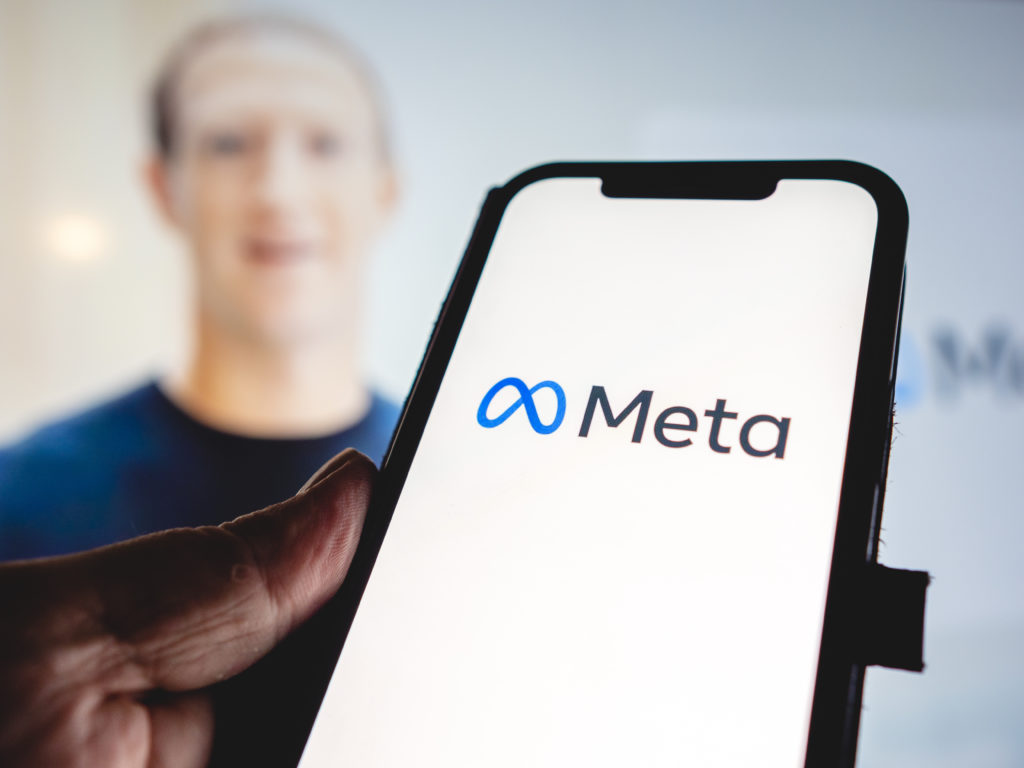“The Web as I envisioned it, we have not seen it yet. The future is still so much bigger than the past.”
— Tim Berners-Lee, Inventor of the World Wide Web.
First, You Have to Understand the Metaverse
When a major player breaks big news in the digital space, Meld’s inclination is to decipher fact from fiction and go straight to the source first. If you read Facebook Founder Mark Zuckerberg’s widely published 10/28/21 “Founder’s Letter”, you learned that the new brand, Meta was introduced. He explained that “Meta brings together Facebook’s apps and technologies under one new umbrella brand.” He went on to tell us that Facebook Metaverse’s focus will be to “bring the metaverse to life and help people connect, find communities and grow businesses.”

Yeah… a bit kumbaya and vague, right? Well, first you need to know what the metaverse is and is not. Simply put, the metaverse is the internet brought to life in a very “wow-producing” way, but not everyone is awe-struck—especially not a Chicago-based tech firm that is suing Facebook for infringing upon its name.
Here at the Melderverse (see what we did there?), we believe that you can liken web 3.0 to that feeling you get when a tsunami is fast approaching on the big screen and you’re sporting those retro-esk blue/red 3D glasses. Instead of looking at the web, you’re actually in the web. See, nothing has changed except prepositions!
Most people think of the metaverse as an amalgamation of VR, AR, 5G…gaming, speed, and spending time with friends and family (or complete strangers) in emerging new spaces yet to be contextualized. But the thing is, it’s actually much more than that.

Zuckerberg has tersely described it as a “virtual environment” where you can go inside of a user experience—instead of just passively gazing into a screen. Essentially, it’s a world of never-ending (see new Meta logo, which is a take on the infinity symbol) communities sharing a vibrant ecosystem where people can do essentially everything that they do in the heart-beating world via use of VR headsets, AR glasses, apps or other shiny new objects.
The move is seen by industry experts, pundits, fundits and snarky Iceland tourism marketers as just a tad underwhelming, as it can be argued that much of this 3.0 stardust has already been thrown up in the air. In other words, many feel we’re already in the next phase of The Information SuperHighway. If you think about the advances made in the gaming world in terms of people exploring heightened new realities, it’s easy to conclude that the Metaverse has already left the station.
So, that begs the question: Is Facebook’s name change simply an intentional device to manufacture thinking among the masses? In other words, was Zuckerberg’s strategic play to package the metaverse as something Facebook created, rather than something that was arguably already in the works? Was the Meta re-brand a cagily masterminded move to enable a strong (almost subliminal) brand association? When you think metaverse (the thing), will you think Meta (the company)? Is Zuckerberg conditioning us to step away from social media snafus by making us believe that a name change maneuver will push negative news stories to the past tense forever? Many who already work, live and play in the metaverse think that this ploy is a red flag as well as a red herring. And yes, it does sound like Zuckerberg stole a page out of the Phillip Morris/Altria PR strategy book of 2003.
Next, Look to the Past
The day after Facebook introduced Meta, we became exponentially curious about how big brands planned on leveraging it to attain marketing goals. How were they going to make money, garner attention and appeal to emotional heart-strings of prospective consumers in this next chapter of tech? We know that much of the future could be dictated by the past, so we perused through the evolution of Facebook ads.
Back in 2004, Facebook launched its first ad revue module called ‘Flyers’ which later became ‘Flyers Pro.’ Today, there are many different types of ad formats and ways to spend digital media dollars at various price points. A lot happens in seventeen years and the metaverse will likely also see iterations of ad revenue streams. It’s important to be realistic about today and tomorrow and the time it takes technology to catch up to what our minds dream up. We are at the beginning of the next chapter of the internet but, realistically, we think that clever developers and digital artisans will continue to focus on WFH virtual tools and settings that have been a byproduct of the pandemic.
Then, Speculate About the Future of Marketing and the Metaverse
Zuck’s holistic vision is likely to expand to dimensions of digital culture such as shopping and social media. Just like the internet, industry insiders are predicting the metaverse will become a necessity for all brands. So let’s unpack this notion, shall we? Where there are brands, there’s sure to be advertising, product placement strategies and influencers. But what will all of this look like in 3D?
Marketing in 2030 may look nothing like the communication touchpoint of today and hot commodities may be items that we can’t even touch or feel as evidenced back in late October when someone bought a CryptoPunk NFT (nonfungible token) for 124,457 ethereum, which converts to roughly $532 million. However, as the cryptocurrency world is still in its infancy, this transaction wasn’t exactly a cut-and-dried move.
Tech Youtuber Sara Dietchy, who has an enviable 821K subscribers, offers her insights. The 26-year-old recently landed a Zoom interview with Zuckerberg earlier this month. We like it because it’s not as scripted and overproduced as Zuckerberg’s formal announcement. In just under a half hour, Sara has Zuck breakdown his vision of Meta and how it fits into the Metaverse. Marketers take note. At 28:25, Sara presses Zuck on potential ad revenue streams within this new frontier. He dodges the question and responds that the focus is much more on building out the creative economy but our call is that there will definitely be ad opportunities in the metaverse and not just embedded in gamification.
As we mentioned, some say Facebook’s announcement is just a deceptive ploy to shift unwelcome attention away from the headline-grabbing controversies of the moment. Others contend that it’s a bold move and a much-awaited Web 3.0 stake in the global ground. A new report from the Harris Brand Platform (a syndicated brand tracker from The Harris Poll that captures the emotional attributes that consumers associate with specific brands) says brand trust among those familiar with the company actually waned after the rebrand announcement (Fast Company 10/28/21).
Last, Keep an Open Mind about the Metaverse—and Stay in the Know
So, what should smart marketers think and feel right now? Is this a sign of inevitable progression in cyberspace, or just a strategic, two-horned damage-control unicorn unleashed to distract the masses? Confused? No worries – our four marketing personas that follow in part two of our metaverse blog feature will help you determine your own thoughts and feelings around this hot topic. In fact, according to Semrush, the average number of monthly searches for the word “metaverse” over the last 12 months was 111.3K globally and 33.1K here in the US (as of 11/24/21). Those numbers mean that there’s a ton of interest in this subject.
This 60 Minutes (6/15/21) story (roughly four months prior to Facebook’s Meta launch) will also help inform your own beliefs and opinions. One thing’s for sure: there seems to be a lot of head-scratching buzz, hearsay speculation, and plain misinformation around the future of the Internet. Isabel Perry, director of technology at Byte, the darling among the burgeoning metaverse marketing technology companies says, “The Metaverse is jam-packed with innovative marketing potential, (ranging) from live shopping to virtual stores, fashion shows, product launches, content production, live flagship events, enhanced social, pimping-up of Zoom calls and NFTs paving the way for real economies. The possibilities that this hybrid digital/physical world offers are near-endless. It’s time for forward-thinking brands to get involved.”
So the shared experience of walking through malls (remember them?) will be just as visually stimulating, and yes, you and your friend (who resides in Sydney, Australia) can grab a smoothie at the food court after you (or rather your avatars) trash the fitting rooms at the digital H&M store. And say you bump into your cousin while in the smoothie line. She’s wearing a fly sweater. Instead of asking her where she got it, you simply click on it and it goes in your closet… that is—your avatar’s closet… or your actual closet… who knows? The point is that brands should be open to the metaverse and how it will (or won’t) interrelate with the Facebook app.
Moreover, various data privacy issues are starting to bubble up too. Marcus Carter, a senior lecturer in digital cultures at the University of Sydney, voiced his concerns about data privacy in Facebook’s metaverse on Friday, saying, “Facebook’s VR push is about data, not gaming… Metaverse technologies like VR and AR are perhaps the most data-extractive digital sensors we’re likely to invite into our homes in the next decade.” (Fortune.com 10/29/21).
Back in the early ‘90s, you might have mumbled to yourself: “This email thing will never catch on.” And that’s okay. There will always be skeptics and cynics who live to debate the effectiveness of innovation, but conversely, there will always be risk takers and eager enthusiasts who salivate over that new hardware smell and the promise of next-level software. At this stage of hypotheticals, we think it’s appropriate to just be open-minded to labs, innovation centers and business incubators who are pushing the tech agenda, creating jobs and new ways to navigate the world. It’s just fun to watch this space right?
Staying informed about hard and soft tech development is one way that you can explore what’s to come. Most of us at Meld like to set Google Alerts to quell FOMO and to get the latest on topics of interest. Following futurists and web trailblazers on Twitter is always a good idea. In fact, according to SearchEngineJournal.com, #metaverse gets about 500+/- Tweets an hour depending on the news cycle. And subscribing to brand spanking new podcasts like Ad Age’s Metaverse channel will keep your curious mind satiated.
Remember the Yellow Sony Sports Walkman?
Melissa Flowerdew-Clarke, a marketing director at a UK-based company called DEPT, feels strongly that “We’re about to hit a 3D, interactive AR technical age. It’s going to be awesome.” Back in July, 2021, DEPT hosted an event to discuss what global marketers and brands need to know. There were the takeaways. Curious?
First, consensus among metaverse pioneers and related tech experts found that the metaverse will be the next major marketing channel. The barometer of this theory could be Wall Street’s eagerness to fund a vision for Epic Games (already estimated at $800 billion).
Still curious? Brands are already swimming in the luke-warm metaverse pool—for now, it might be in the safe shallow end, but still, interest of megabrands is gaining traction. “Balenciaga has held virtual fashion shows. Gucci has created digital-only products. Star Wars created an island within the Fortnite game which allowed users to watch a film clip; and, also inside Fortnite, DJ Marshmello performed to 11 million virtual viewers.” (DEPT: 5 Key Takeaways: the CMO’s Guide to the Metaverse.) This all translates into $$$$ – new revenue streams for brands with superfans who are particularly from GenZ or the Alpha Generation (both digital natives).
The fact is, humans are intrinsically intrigued by digital worlds. And now Extended Reality (xR) is blurring the line between fact and fiction. By the way, xR is merely a hierarchical descriptor for how we can talk about augmented reality, virtual reality and mixed reality together as one. Read this Rolling Stone article to unearth a deeper dive.
The last takeaway? Ongoing technological innovation will power the future of the metaverse. The metaverse is currently at the yellow Sony Sports Walkman ($380 on ebay, in the package) phase of the collective journey. But the beginning is a pretty wonderful place to be. Just ask disguise software. Designers and creators can play around with skills which allow them to make 3D objects and navigate around strange, wonderful and highly imaginative spaces. The robust tools are here, which means the seeds are now being planted.
Life Imitating Art, Imitating Life, Imitating Art? That’s So meta
If you’re still curious, our advice would be to read “Snow Crash” by Neal Stephenson (published by Del Rey 1/1/2000). It’s where the term Metaverse was actually minted.
“Ready Player One” is also a great contextual resource. This Spielberg box office smash grossed $582,893,671 back in April of 2019. The highly referenced sci-fi thriller is set in 2045 where the real world is a harsh place. The only time when the main protagonist feels truly alive is when he escapes to The OASIS, “an addictive, immersive virtual universe where most of humanity spends their days.” Kind of makes you wonder if the future will be rated PG-13, with adult subject matter and scenes for mature audiences, right?
By jumping in and demystifying some of the fundamentals of the metaverse, brands of all sizes and sectors are beginning to sniff out what qualities and experiences will shape the fusing of physical and pixel. It’s good to be experimental.
For example, this past summer, Ray-ban and Facebook gave us a glimpse of their smart glasses, and while not exactly advanced, for less than $300 you can capture, share and listen in a very James Bond sort of way. Big brands are taking chances and wowing fan bases in big ways. For instance, Snapchat is wooing early adopters with fun AR technology called Local Lenses. You can try on a pair of Adidas or Nikes, a sample of almost anything. Technology like this is why the global AR market is projected to grow from $6.12 billion in 2021 to reach $97.76 billion by 2028.
Another example? One Melder here at headquarters especially loves the app YouCam Make-up, which she downloaded about three years ago. It bills itself as the ultimate #1 selfie editor tool and makeover camera app, but it’s so much more. In just a few seconds, she can put make-up, get rid of those unsightly eye bags and brighten her teeth, and whamo-jamo—she’s ready for IG primetime. Here’s the kicker—when you fall in love with your new look, the app then suggests real life products in order for you to achieve the effects legitimately.
The examples continue. Many people find that NFTs are viewed as the gateway to understanding the metaverse. NFTs are kind of like “collectibles” for brands. They have one owner (or fractional ownership), with that ownership fully tracked via the blockchain. For uber expensive items, NFTs are a unique opportunity to provide more attractive options for eager consumers. NFTs also allow for the native creator to still receive a percentage of profits as the NFT escalades in value. If you’ve made it this far, you deserve a treat and here it is—an SNL skit about NFTs. You’re welcome.
If you’re as fascinated by this technology as we are, why not research brands who have already taken a nibble out of AR experimentation like Kate Spade and Ikea? BMW launched a streaming platform known as Joytopia, which will eventually become its home for digital events. In these early stages however, Joytopia is a place to test interest, host exclusive VIP virtual events (Coldplay helped create buzz) and receive consumer feedback that could dictate Joytopia 2.0. We think car giveaways are probable.
But will other brands follow their lead? That’s still up in the air. It’s a commonly held position that in 2021, CMOs and forward-thinking Ad Execs may be a bit apprehensive to take the leap without a promise of imminent ROI, but brave brands that plan for the long-term ride of these sweeping innovations will see much higher returns from the metaverse compared to brands that immediately try to capitalize on the novelty and chasing after the almighty dollar.
It’s interesting to note that Quest 2 (Meta’s widely-popular virtual reality headset) has sold 1.4 million units according to recent Q3 Figures. Global shipments of Quest 2 headsets had increased by 52.4 percent year-on-year in 2021’s first fiscal quarter. And perhaps that’s the best indicator of consumer interest. (xrtoday.com 11/2/21)Whether it’s creating something that drops jaws or jumping in to experience something you read on TechCrunch or signing up for an algorithm-less Discord server to learn more from other metaverse groupies, you can easily be on the up-and-up about how the metaverse has iterated.
Metaverse Opportunities Don’t Stop at Marketing
The metaverse is not just about play.Immersive learners, rejoice! Beyond brands, there are compelling and remarkable advances in edtech as well. From field trips without leaving the classroom to visually transporting schoolchildren to specific points of time in history – the experience for kids is unforgettable and studies show that kids learn at a higher rate when they don’t realize they’re learning!
And for adults who learn by doing, you’re in luck too. All of this is possible due to creators, developers and dreamers who are proactive in moving the needle of metaverse experiences. If these doers have the tenacity and will to create worlds in 3D then we as a society should be proactive in exploring them and giving them a chance.
Last But Not Least
Want to learn more about specific ways the metaverse will affect marketers? Check out our Metaverse Part II blog (coming soon!) where you’ll read about four different marketing reactions to Meta and the metaverse.



